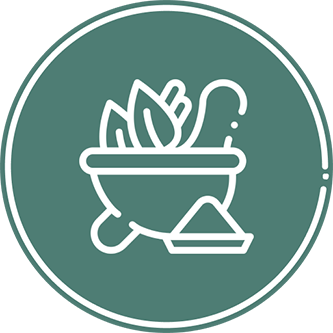For example, some individuals who are hyperactive, may have the overpowering presence of Vata Dosha as this Dosha is characterized by movement. Vata ensures the functioning of our body movements, both internal and external, take place seamlessly. This includes oxygen absorption in the body and organs, functioning of the nervous system, breathing, movement of the musculoskeletal system, i.e., bones, muscles, tendons, ligaments and soft tissues and bodily excretions. Those with a Vata nature tend to be talkative, enthusiastic, creative, flexible, and energetic. When Vata Dosha is imbalanced, individuals may experience confusion and overwhelming emotions, difficulty in focusing and sleeping disorders.
Ashwagandha, Giloy, Brahmi, Ginger and Fennel are good for balancing the Vata Dosha.
}}
The second Dosha, Pitta, maintains the balance between fire and water in our body. Pitta governs the principles of digestion, heat generation, and transformation. If a person easily loses their temper easily, they might have an imbalance of Pitta dosha. Pitta also imparts warmth, vision and colour to the human body. Hence people who tend to sweat a lot, feel warm and have oily skin, tend to identify to have more characteristics of Pitta. An imbalance of Pitta may cause diarrhoea, infections, skin rashes and weakness in the liver, spleen, and blood.
Amalaki (amla), Neem and Mint are herbs that are good for balancing the Pitta Dosha.
}}
The third dosha, Kapha, governs the lubrication of all our body parts, primarily the joints. Kapha stabilises the body structures with muscles, tendons, ligaments and fats. It protects our joints, the brain and the spinal cord, by covering it with fluids which help absorb shock. Characteristically, those with Kapha nature handle stress well, but don’t like change, are conservative, and comfort seekers. This relates to the soft, watery nature of Kapha. An imbalance of the Kapha Dosha might sprout depression, laziness and lethargy.
Neem, Tulsi, Triphala, Turmeric - are good for balancing the Kapha Dosha.
}}
Ayurveda says that at the time of birth, there is a natural equilibrium of energies. However, this does not mean that all three Doshas are present in the same ratio, but what it signifies is that each individual is born with well-balanced energies. When a baby is born, it is believed that Kapha Dosha is most active, in teenagers Pitta Dosha is more prominent, and as an individual’s age progresses, The Vata Dosha is mostly overpowering the others.
Ayurvedic doctors can be consulted for analysing and balancing the Doshas of an individual. Pravek’s range of single herb capsules are available online and over-the-counter. Pravek Ashwagandha and Giloy capsules can be taken to correct Vata Dosha imbalance. Pravek Neem capsules can be taken to balance the Pitta Dosha and Pravek Tulsi capsules can be taken to balance the Kapha Dosha.
}}


















